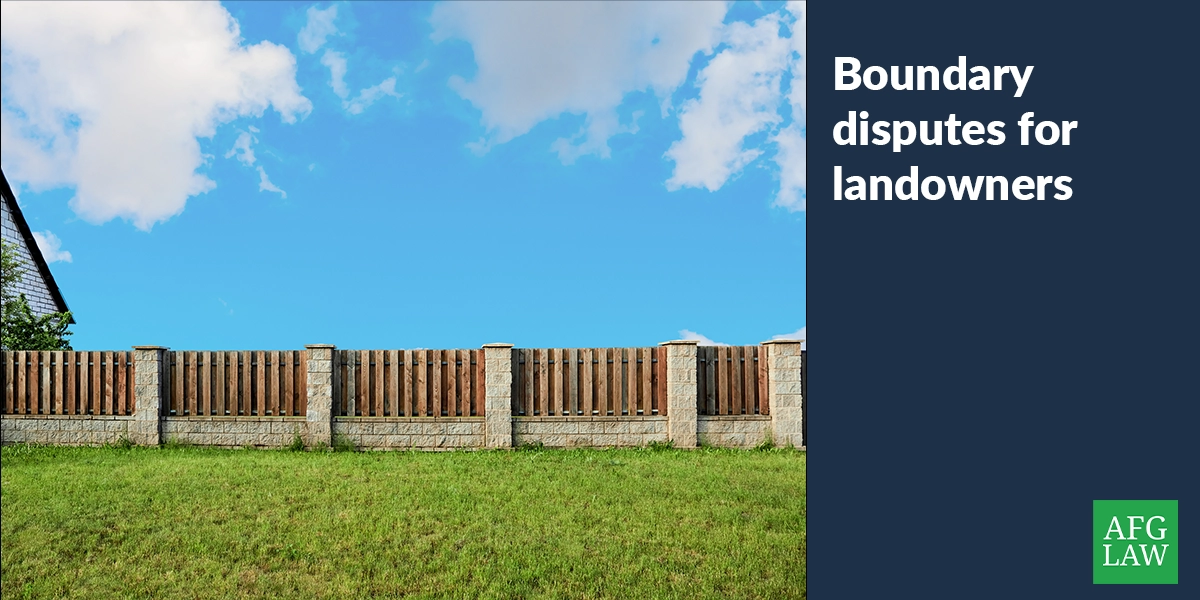Dealing with a boundary dispute can escalate quickly, be time-consuming and frustrating. UK laws surrounding boundary disputes can also be quite complex, meaning tackling them alone can be quite daunting.
If you’re a landowner, this guide will help you understand the intricacies of boundary disputes and what you should do to resolve them.
What are boundary disputes?
Boundary disputes are disagreements between neighbours about the location of the boundary between their properties.
There is usually no record of the exact measurements of the boundaries between two properties, which is the reason many boundary disputes arise.
What causes boundary disputes?
Boundary disputes can be caused by a number of different reasons, including:
Unclear property descriptions
Poorly assembled fencing
General misunderstandings between neighbours
Changes in land use
Disagreements about land access
Material claims, such as land and water rights
Types of boundary disputes
Fence and wall disputes
To separate two properties, there could be a boundary feature; this could be a fence, hedge or wall. There may not be any feature defining the boundaries at all. If there is no feature to the boundary, this could increase the difficulties as to precisely defining any boundaries. If this is the case, it may require a survey to be carried out.
Easement disputes
Easements grant specific rights to others, such as the right of way or property access. These disputes arise when there are disagreements around land access.
Resolving easement disputes will typically involve reviewing property documents and historical use.
Adverse possession claims
These claims occur when one party occupies another parties property continuously for a period of time without the owner's objection. Disputes arise when the occupier claims legal ownership based on their extended possession.
This can be a very intricate issue and will usually require the assistance of an experienced solicitor.
Encroachment disputes
Encroachment disputes arise when a structure extends onto another party's property line. These arguments usually arise due to miscommunications during construction or property alterations.

Examples of common boundary disputes
Some other common types of boundary disputes include:
House extension disputes
Maintenance and repairs
Location of pipes and drains
Driveway issues
Trees and bushes
Property line widths
How to resolve boundary disputes
There are various ways to attempt to resolve a boundary dispute; these involve the following:
Negotiating with the other party and/or their solicitors;
Obtaining a land survey which details the boundaries;
Making an application in respect of the boundaries.
The likelihood is that it will involve more than one of the options above. Additionally, the nature of any boundary dispute will likely involve various back and forth with the neighbours and/or solicitors in an attempt to negotiate an agreement to avoid court proceedings.
Seek legal advice
We recommend that you seek legal advice to help you resolve a boundary dispute, as the negotiations involved can be frustrating, upsetting and time-consuming. Expert advice is there to maximise your chances of bringing your dispute to a successful conclusion, whilst minimising your costs and risk.
Collect relevant evidence
It is also advisable that if you have any photographs for any period of time relating to the boundary that these are kept. If there are any objects such as rocks which define the boundary that are currently there, it is advised to keep records of them and any movement to assist you.
Obtain a land survey
The next step is to have your Land Registry documents reviewed by a solicitor who will then be able to advise you further. Sometimes there can be more than just the Land Registry title plan that is relevant in defining the boundary - more often than not, old title deeds are reviewed and referred to.
Legally determining a boundary on your land
To legally determine a boundary on your land, you must apply for a determined boundary.
In order to apply for a determined boundary, you must have/prove the following:
Your property must be registered
You must show the results of a land survey
Evidence, such as photographs supporting your application
A completed exact line of boundary form
This application will cost £90 and you will also need to pay the surveyor and solicitor fee. If your neighbour agrees with your application, they will also need to sign the form and the plan too.
What evidence is needed for a boundary dispute?
When resolving a boundary dispute, some evidence which might be needed can include:
Certified copies of deeds to the property
Surveyor reports
Old ordnance surveys
Photographs, including ariel and family photos
Written and signed statements
FAQs about boundary disputes for landowners
Is there a time limit on boundary disputes?
There are no set time limits for resolving a boundary dispute, however, there are time limits for certain claims.
The old rules of adverse possession are based on the statute of limitations, meaning an injured or dispossessed party cannot recover the land after 12 years of adverse possession.
How much does the average boundary dispute cost?
The costs of boundary disputes can vary depending on the issue at hand and the complexity of it. It is not uncommon for both sides of a boundary dispute to run up costs, which is why we always recommend aiming to reach an amicable agreement first.
If you would like advice regarding any of the above, please contact our Dispute Resolution Team on 01204 377600 or email disputeresolution@afglaw.co.uk.
